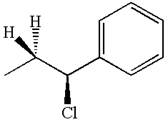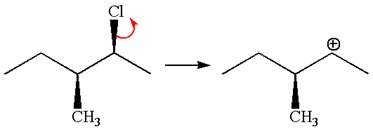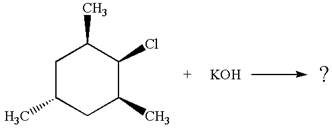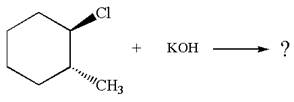
Concept explainers
(a)
Interpretation:
The detailed mechanisms for the given reaction occurring via
Concept introduction:
The
In case of
Answer to Problem 8.44P
The


The

Explanation of Solution
The given reaction equation is:

In the given reaction,

The hydrogen atom, indicated with the dash bond, is anti to

If the hydrogen atom, indicated with wedge bond, tends to eliminate, it must orient anti to

In

The products formed for the given reaction from both
(b)
Interpretation:
The detailed mechanisms for the given reaction occurring via
Concept introduction:
The
In case of
Answer to Problem 8.44P
The

The

Explanation of Solution
The given reaction equation is:

In the given reaction,

In

The products formed for the given reaction from both
(c)
Interpretation:
The detailed mechanisms for the given reaction occurring via
Concept introduction:
The
In case of
Answer to Problem 8.44P
The


The



Explanation of Solution
The given reaction equation is:

In the given reaction,


In

In the second step, the base abstracts the proton from the carbon adjacent to the positively charged carbon. Two products are possible because the proton gets eliminated from two different carbon atoms. The detailed mechanism is shown below:


The products formed for the given reaction from both
(d)
Interpretation:
The detailed mechanisms for the given reaction occurring via
Concept introduction:
The
In case of
Answer to Problem 8.44P
The


The





Explanation of Solution
The given reaction equation is:

In the given reaction,


In

In the second step, the base abstracts the proton from the carbon adjacent to the positively charged carbon. Two products are possible from the secondary carbocation because the proton is eliminated from two different carbon atoms.


The carbocation formed is a secondary carbocation, which can be rearranged to a more stable tertiary carbocation by

Two products are possible from the tertiary carbocation because the proton is eliminated from two different carbon atoms.


Thus, in all the reactions above, the products are formed by
The products formed for the given reaction from both
(e)
Interpretation:
The detailed mechanisms for the given reaction occurring via
Concept introduction:
The
In case of
Answer to Problem 8.44P
The


The



Explanation of Solution
The given reaction equation is:

In the given reaction,


In

In the second step, the base abstracts the proton from the carbon adjacent to the positively charged carbon. Two products are possible because the proton is eliminated from two different carbon atoms. The detailed mechanism is shown below:


The products formed for the given reaction from both
(f)
Interpretation:
The detailed mechanisms for the given reaction occurring via
Concept introduction:
The
In case of
Answer to Problem 8.44P
The

The





Explanation of Solution
The given reaction equation is:

In the given reaction,

In

In the second step, the base abstracts the proton from the carbon adjacent to positively charged carbon. Two products are possible because the proton is eliminated from two different carbon atoms. The detailed mechanism is shown below:


The carbocation formed is a secondary carbocation, which can be rearranged to form more stable tertiary carbocation by

Two products are possible from the tertiary carbocation because the proton IS eliminated from two different carbon atoms.


The products formed for the given reaction from both
Want to see more full solutions like this?
Chapter 8 Solutions
Organic Chemistry: Principles and Mechanisms (Second Edition)
- Draw the complete, detailed E1 mechanism for each of the following reactions, and show all resonance structures, where applicable.arrow_forwardDraw the complete mechanism with curved arrows for the formation of each of the following products.arrow_forwardDraw this compound in a chair form so that an E2 reaction is possible. Then, draw the mechanism and the major product. Your solution and structures must clearly show the 3D nature of the E2 mechanism.arrow_forward
- Draw the products obtained in each of the following reactions, and then circle the major product.arrow_forwardNeed help with question. Determine if each reaction proceeds via E1 or E2. Draw all possible products that can result depending on the mechanism. Identify the major product.arrow_forwardDraw a detailed mechanism of the following reactions and determine the major product:arrow_forward
- Submit the mechanism for the following reaction. Use the mechanism you draw to match this reaction with the correct energy diagram.arrow_forwardProvide the mechanism for each step of the given reaction, showing the major product as well.arrow_forwardHelp please. Draw the curved arrow notation and products for the each elementary step described by the sequence shown here.Note that the products of each step should be used as the reactants in the next step, and you may need to draw in additional reagents as directed. Remember to click on each box to see step-specific instructions. Draw H3CH2C–, and then add the curved arrow notation showing a nucleophilic addition.arrow_forward
 Organic Chemistry: A Guided InquiryChemistryISBN:9780618974122Author:Andrei StraumanisPublisher:Cengage Learning
Organic Chemistry: A Guided InquiryChemistryISBN:9780618974122Author:Andrei StraumanisPublisher:Cengage Learning
